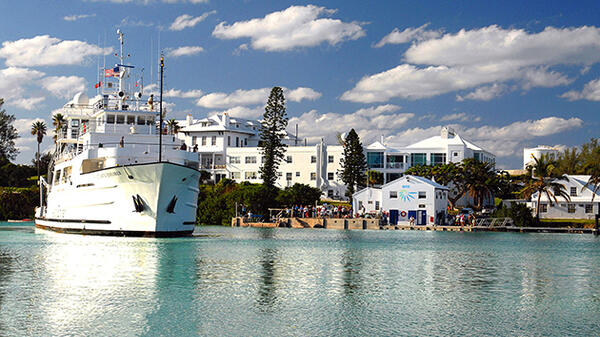For millennia, the exchange of CO2 (carbon dioxide) between the ocean and atmosphere has been in balance. Now, with more human-caused, or anthropogenic, carbon-dioxide in the atmosphere, the ocean is taking up more CO2 as well. This additional CO2 is negatively impacting sensitive ecosystems and scientists worry how changes to the ocean environment will affect the way carbon is cycled through the seas. Tune in to Changing Seas The Fate of Carbon, which features BIOS scientists working on the Bermuda Atlantic Time-series Study (BATS), which has collected data on the physical, biological, and chemical properties of the ocean since 1988. Learn how these measurements are helping us learn more about the role of carbon, and the ocean, in Earth’s changing climate.
MAGIC Room Opens at BIOS
August 10, 2016

BIOS welcomed the first student users of its new high-tech facility known as the MAGIC Room—a room designed to facilitate data analyses, scientific collaboration, and learning among students and visitors from Bermuda and abroad. Students sat at a large, U-shaped table in swivel chairs that pivoted for views of multiple screens, including a multi-screen video wall at the front of the room and an 84-inch high-definition touchscreen on an adjacent wall. As underwater gliders roamed the ocean 50 miles away, students discussed the gliders’ near-real time measurements of oxygen, salinity, current strength, and other incoming physical and chemical data.
BIOS’s Hydrostation S Receives Five More Years of Funding
December 12, 2016

Hydrostation S, the world’s longest-running hydrographic time-series with a location offshore Bermuda, has received a commitment for another five years of support from the National Science Foundation (NSF). The funding includes $900,000 for research and $3.1 million to support 120 days of research at sea on board the BIOS-operated research vessel Atlantic Explorer.
A Giant Effort for Tiny Marine Plankton
April 30, 2021

The quest to understand a very small, yet critically important, part of the marine food web proved especially challenging this spring during the ongoing global health pandemic. For participating scientists and university students, the process started in December 2020 with a 14-day quarantine period in Hawaii, where they were prohibited from leaving their hotel rooms, even for a walk. Then there were five COVID-19 tests for each (all negative). Next came days of sea travel past the Tahitian Islands and the Equator, with all 39 people on board the research vessel Roger Revelle wearing masks and trying to stay socially distant for the first two weeks of the trip (as much as possible on a 277-foot ship).
Big News for the Study of the Ocean’s Smallest Organisms
September 30, 2021

BIOS is one of thirteen academic and research institutions participating in a newly-announced National Science Foundation (NSF) Science and Technology Center (STC) intended to develop a deeper understanding of the role that marine microbes play in changing ocean conditions and the global carbon cycle. Over the next five years, the STC will leverage recent scientific advances, incorporate new technologies, and engage educators and policymakers to promote a deeper understanding of the chemicals and chemical processes that underpin ocean ecosystems.
Good News for Three Long-Term Ocean-Monitoring Programs at BIOS
October 30, 2021

BIOS senior scientist and director of research Nick Bates boosted his research portfolio earlier this month when he received news of three funding renewals for long-term ocean-monitoring programs at BIOS.
Shipboard Teamwork
October 25, 2021

During the last two years, a team of researchers and technicians from BIOS have worked diligently alongside crew of the BIOS-operated research vessel Atlantic Explorer to maintain near-continued operations throughout the pandemic.
Tracing a Water Journey
October 14, 2017

In the Southern Ocean, cold surface water sinks to about 1,500 feet (500 meters) and travels in the dark for thousands of miles before resurfacing, some 40 years later, near the equator in the Pacific, Atlantic, and Indian ocean basins. Scientists call this major water mass the Sub-Antarctic Mode Water, or SAMW, and it is regarded as a powerhouse of a mixer in the oceans. It’s also critical to marine life; when it warms and rises into the sunlit subtropical and tropical waters, the nutrients it contains are estimated to fuel up to 75 percent of the microscopic plants growing there.
A BIOS REU, Times Two
February 04, 2016

Chloe Emerson initially came to BIOS in the fall of 2014 for the Research Experiences for Undergraduates (REU) internship program funded by the National Science Foundation. As a Wellesley College senior working to complete her major in Biology and minor in Philosophy, Emerson already found developmental biology and stem cell research fascinating. At BIOS, these interests crystalized as she began to study sea urchins in Andrea Bodnar’s Molecular Discovery Laboratory, leading her down a path in regenerative biology that she hardly could have imagined two years ago.
A Showcase for Innovative BATS Research
February 04, 2016

To maintain the unparalleled 27-year record of natural ocean processes and human-induced change at the Bermuda Atlantic Time-series Study (BATS) site, four BIOS research technicians work to collect monthly measurements at sea, process samples in the lab, and analyze incoming data. Over the past year, each of them has also gone beyond their basic duties with research forays into the time-series dataset. This month, the four traveled to New Orleans, Louisiana, to present their results at the 2016 Ocean Sciences Meeting.
